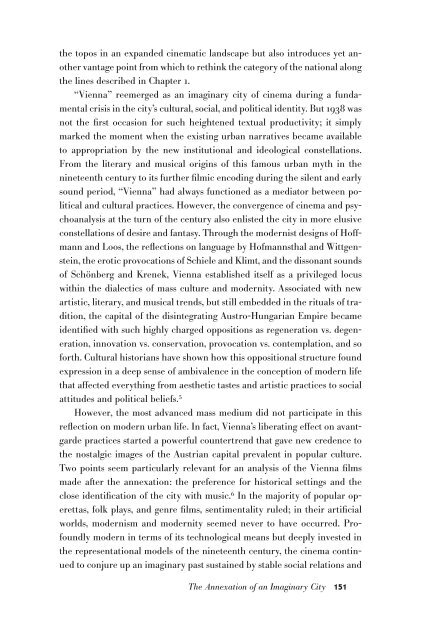You also want an ePaper? Increase the reach of your titles
YUMPU automatically turns print PDFs into web optimized ePapers that Google loves.
the topos in an expanded cinematic landscape but also introduces yet another<br />
vantage point from which to rethink the category of the national along<br />
the lines described in Chapter 1.<br />
“Vienna” reemerged as an imaginary city of cinema during a fundamental<br />
crisis in the city’s cultural, social, and political identity. But 1938 was<br />
not the first occasion for such heightened textual productivity; it simply<br />
marked the moment when the existing urban narratives became available<br />
to appropriation by the new institutional and ideological constellations.<br />
From the literary and musical origins of this famous urban myth in the<br />
nineteenth century to its further filmic encoding during the silent and early<br />
sound period, “Vienna” had always functioned as a mediator between political<br />
and cultural practices. However, the convergence of cinema and psychoanalysis<br />
at the turn of the century also enlisted the city in more elusive<br />
constellations of desire and fantasy. Through the modernist designs of Hoffmann<br />
and Loos, the reflections on language by Hofmannsthal and Wittgenstein,<br />
the erotic provocations of Schiele and Klimt, and the dissonant sounds<br />
of Schönberg and Krenek, Vienna established itself as a privileged locus<br />
within the dialectics of mass culture and modernity. Associated with new<br />
artistic, literary, and musical trends, but still embedded in the rituals of tradition,<br />
the capital of the disintegrating Austro-Hungarian Empire became<br />
identified with such highly charged oppositions as regeneration vs. degeneration,<br />
innovation vs. conservation, provocation vs. contemplation, and so<br />
forth. Cultural historians have shown how this oppositional structure found<br />
expression in a deep sense of ambivalence in the conception of modern life<br />
that affected everything from aesthetic tastes and artistic practices to social<br />
attitudes and political beliefs. 5<br />
However, the most advanced mass medium did not participate in this<br />
reflection on modern urban life. In fact, Vienna’s liberating effect on avantgarde<br />
practices started a powerful countertrend that gave new credence to<br />
the nostalgic images of the Austrian capital prevalent in popular culture.<br />
Two points seem particularly relevant for an analysis of the Vienna films<br />
made after the annexation: the preference for historical settings and the<br />
close identification of the city with music. 6 In the majority of popular operettas,<br />
folk plays, and genre films, sentimentality ruled; in their artificial<br />
worlds, modernism and modernity seemed never to have occurred. Profoundly<br />
modern in terms of its technological means but deeply invested in<br />
the representational models of the nineteenth century, the cinema continued<br />
to conjure up an imaginary past sustained by stable social relations and<br />
The Annexation of an Imaginary City 151

















